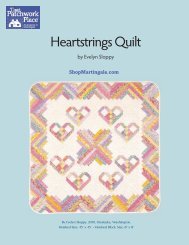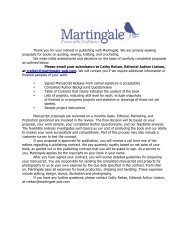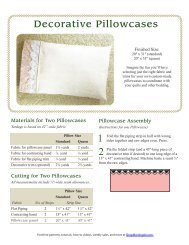Paper-Foundation Piecing - ShopMartingale
Paper-Foundation Piecing - ShopMartingale
Paper-Foundation Piecing - ShopMartingale
Create successful ePaper yourself
Turn your PDF publications into a flip-book with our unique Google optimized e-Paper software.
What is <strong>Paper</strong>-<strong>Foundation</strong> <strong>Piecing</strong>?Sometimes called simply “foundation piecing,” othertimes called “paper piecing,” stitching fabric onto a paperfoundation allows you to stitch with amazing accuracy. Ifyou love long, slender, pointy points and precise piecing,The basic idea of paper-foundation piecing involves printingor tracing your block pattern onto a piece of easy-totearpaper. Then you sew fabric pieces to the wrong sideof the paper, using the lines on the right side of the paperfor guidance. Since you’re sewing on the line and usingaccurate. When all the sewing is complete, you tear awaythe paper and your beautiful block remains.To help you achieve success, I’ve included a couple oftips, and I’ll warn you about the common pitfalls so thatyou can avoid potential problems. For example, onething I’ll mention here is that paper piecing takes morefabric than conventional piecing. There’s always a littlemore fabric wasted. On the other hand, paper-foundationpiecing makes great use of scraps and oddly shapedyourself a favor and try paper piecing. If accurate piecingmakes your heart sing, paper-foundation piecing may beyour perfect method.Getting Started with <strong>Paper</strong>-<strong>Foundation</strong><strong>Piecing</strong>As with all new techniques, it’s best to start with a small,fairly simple paper-piecing pattern. (Thus speaks thewoman who quilted a king-size quilt for her parent’s wed-You’ll need one paper pattern for each block you wantto make. You can copy the pattern onto the foundationmanentmarker (pencils and ballpoint pens will smear, sothe foundation paper. I suggest you make an extra copy orAs for the type of foundation to use, paper-piecing paperis available at your local quilt shop and online. Test sev-I’ve used cheap copy paper, tracing paper, baking parch-on what I had on hand at 7 o’clock on a Sunday night. Thebest paper will tear easily along the stitching lines, won’tdationpaper also needs to be translucent enough thatyou can see pieces of fabric through the paper when youhold it up to the light.2 <strong>Paper</strong>-<strong>Foundation</strong> <strong>Piecing</strong>
Punchy Tipone or two copies of your pattern and you don’t have aphotocopier available. Use craft scissors to cut the foundationpaper into however many squares you need in asize slightly larger than your block pattern. For example,with the outer seam allowance, so cut squares 7" or so.They don’t have to be accurate squares; rough cuttingAccurately trace the pattern onto one of the squares, orfoundation-paper squares together, with the traced orcopied pattern facing up on top. Staple the stack togetherin about four places, stapling where there are no stitchinglines so you can sew over the lines. You need enoughstaples so the papers don’t shift, but not so many that thePlace the stapled squares under the machine, lower thepresser foot, and stitch on all of the drawn lines(including the outer dashed line to mark the seam allow-doesn’t really matter. The needle punches holes throughall the foundation papers. The line of holes acts as yourstitching line and also makes it extra easy to tear awayWhen you’re done stitching, remove the staples andseparate the foundation papers. Because the punchedpatterns won’t have markings on them, you may eitherwant to write the piece numbers on each pattern sothey’re easy to follow, or you can keep the original masterpattern to follow as a guide; save that one for stitchingon last. Use the hole lines as a guide when you sew thefabric to the foundation.StapleStapleStapleStapleStitch over all the lines without using thread.Remove staples.Remove the thread from both the top and bobbin ofyour machine and replace your sharp new needle withme and haven’t replaced your needle in awhile, keep theold needle in the machine but plan on replacing it afteryou’ve made all your foundation patterns.4 <strong>Paper</strong>-<strong>Foundation</strong> <strong>Piecing</strong>
3Each section of the pattern is numbered toindicate the piecing sequence. Begin by sewingpiece 1 to piece 2 along their shared line. Start with theyellow 3" square of fabric for piece 1 and the blue 5" x 5"square for piece 2. Place the yellow square right side upon the wrong side of the foundation paper so that itcovers section 1. Hold the foundation-paper square upto a light with the printed side facing you and move thefabric around until one edge of the fabric extends about¼" beyond the line between piece 1 and piece 2. Notonly should the piece 1 shape be completely shaded bythe fabric, but the fabric should also extend ¼" beyondthe shape on all of the sides. Pin piece 1 to the paper.With right sides together, layer the piece 2 fabric ontopiece 1, matching the edges parallel to the line betweento completely cover the piece 2 shape plus a ¼" seamallowance all around. To check this, turn the foundationover and pinch the fabric right at the seam line. Flip theblue square over to check that it will cover all of piece 2on the foundation ¼". Now you understand why it’sbetter to precut your pieces a little too large instead oftoo small. I’m constantly surprised where the fabric actu-<strong>Foundation</strong>paper (top)Position fabric right sides togetherunder the foundation paperPiece 2right side upfacing piece 1Piece 1 wrongside toward paperPiece 2plus 1/4"4Place a pin to hold the fabric pieces in place on thefoundation paper. Place the paper and fabric underyour machine with the paper on the top. Set your stitchlength a little shorter than usual—I usually sew withmy machine set at about 12 stitches per inch, or about2 on my machine. For paper-foundation piecing I set itaround 1.5, or about 17 stitches per inch. The shorteris pieced. It also makes it harder to take out mistakes, soexperiment with the best stitch length for your temperament.You may prefer it a little shorter or longer than whatI use.(If you made needle-punch patterns, did you remember toStitch along the line between pieces 1 and 2 on the foundationpaper. I like to start and stop about ¼" beyond theline, but other quilters prefer to take a short backstitch atthe beginning and end of stitching instead. You need todo one or the other to keep the seams from pulling apartStitch 1/4"past line.1/4"Stitch on the line betweenpiece 1 and piece 2.5Double-check that piece 2 covers enough area, and trim the excess fabric, leaving approximatelybut more meticulous quilters like to fold back the foundationpaper along the seam line and use a rotary cutter andsmall ruler to trim the extra fabric to an accurate ¼" seamallowance. Either way, be sure to trim to reduce the bulkin your block.Trim to a 1/4" seam allowance.5 <strong>Paper</strong>-<strong>Foundation</strong> <strong>Piecing</strong>
6 get a pretty good crease, or use your iron. Whenyou iron foundation paper, be aware that sometimesphotocopy ink will transfer to your iron, and then ontoyour fabric, so it’s best to use a pressing cloth or wastefabric between the paper and your ironing board. I alsoavoid using steam, since that can dampen and crinkle thepaper, making the process not as accurate as you’d like.allowance. Press toward piece 2.7Position the blue 4" x 7" rectangle for piece 3 rightsides together with pieces 1 and 2 and hold thepattern up to the light so you can guesstimate that piece3 extends ¼" beyond the stitch line between pieces 1and 2 and piece 3. Flip the pattern over and check thatpiece 3 covers the foundation pattern plus extra for seamallowances. Pin piece 3 in place and stitch along the lineas you did in step 5. Stitch past the line all the way to theedge of the paper.Position piece 3 right sidestogether with pieces 1/2.Piece 2 plus 1/4"Check that piece 3 ispositioned properly.Fixing MistakesWelcome to paper piecing. Everyone’s done that, butbecause of the short stitches and the rigidity of the paper,the problem right away, and not four seams later, here’sFlip the foundation unit so the paper is facing you. Placea strip of transparent tape along the stitched seam andpress on it so it has a good hold on the paper. Now withone hand, grab the foundation paper close to the end ofthe seam and take a good hold of the fabric in your other-pulled from the paper. Now it is easy to snip every threestitches or so and pull out the seam. The foundation isstill intact and you can reuse it to restitch your pieces.TapeIf you don’t mind wasting a bit of fabric, here’s anotherway to remove a mistake. Using fabric scissors, cut awaythe seam allowance of the newly added fabric allowance as close as possible to the stitching line. Thensimply pull the big chunk of remaining fabric away fromthe stitching. The thread stitching line is still there, butthe fabric is gone and the foundation is intact. Add a newpiece 2 fabric and sew one thread’s width away from thefew seconds to accomplish, the foundation isn’t torn, andStitch on the line betweenpieces 1/2 and piece 3.6 <strong>Paper</strong>-<strong>Foundation</strong> <strong>Piecing</strong>
8Check that the piece 3 fabric is covering the piece3 foundation shape plus ¼" seam allowances; thentrim the excess along the seam and press open. If theexcess fabric beyond the paper’s edge is bothersome,the block’s edges after all of the pieces are sewn. I havetwo reasons for doing this. The reason I usually share withfolks is that I tend to trim only when I need to in case I’vemade a mistake and have to rip out seams. If I trim toosoon, I’m likely to cut away fabric I'll need. The otherreason is I’m too lazy to trim piece by piece and I’velearned to ignore the excess fabric.10After all the pieces are sewn, press yourblock with a medium-hot iron. Remember to usea pressing cloth over the photocopied side of the paperin case the ink smears, and don’t use steam because itwill dampen the paper. Trim your block to the lineTrim to a 1/4" seam allowance.Press toward piece 3.9Repeat steps 7 and 8 with the remaining pieces,sewing in order and trimming and pressing afteradding each piece.11 pieces are easy, but the tiny bits in seams can bethen sliding a pair of long, sharp tweezers inside the seamand giving a tug with the tweezers is the easiest methodof paper removal. The tweezers are also helpful in removinglittle bits of paper that can get caught in the stitching.If you make multiple blocks, you may decide to wait toremove the paper until after all the blocks are stitchedtogether. If you wait to remove the paper, it’s a snap tosew the blocks together, but then there are more seamsfrom which to tear the paper. Some people make theiroutside the edge of the paper. Try both methods and seewhich you prefer.Piece 4 sewn.Piece 5 sewn.Removing <strong>Paper</strong> Can Be a Snap<strong>Paper</strong>s for <strong>Foundation</strong> <strong>Piecing</strong>, tissue paper, or bakingparchment, and you’ve set your stitch length to be prettyshort, you can try this technique for releasing the paper.stitching line. Give the block a quick tug in oppositeseams, but you may still need to resort to using tweezersin areas where multiple seams come together, such as innarrow points.7 <strong>Paper</strong>-<strong>Foundation</strong> <strong>Piecing</strong>
If you’re the type of person who likes to end up withthem together to make a pretty star pillow or smallwall hanging.Symmetrical or Asymmetrical?With paper piecing, the image you end up with will be amirror image of the paper pattern.You always want to stitch on the correct side of the paperUnit AUnit BFour blocks combine to make a twisted star.© 2012 by MartingaleAn Imprint ofMartingaleCreate with Confidence19021 120th Ave. NE, Ste. 102Bothell, WA 98011 USA(800) 426-3126www.<strong>ShopMartingale</strong>.com8 <strong>Paper</strong>-<strong>Foundation</strong> <strong>Piecing</strong>
3721645<strong>Foundation</strong>-paper-piecing patternPattern includes an outer 1/4" seam allowanceand creates a 6" finished block.Pattern is reversed forfoundation paper piecing.Martingale grants permission for photocopying this page only.9 <strong>Paper</strong>-<strong>Foundation</strong> <strong>Piecing</strong>






